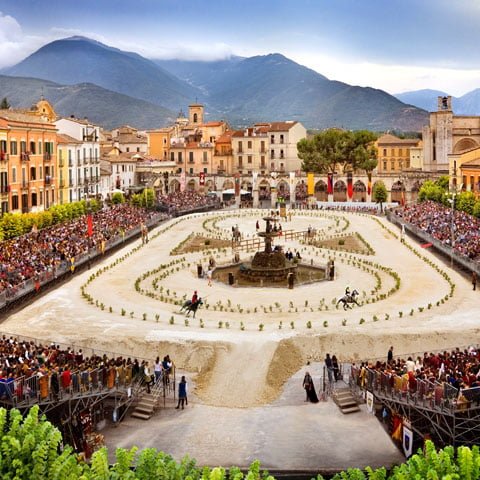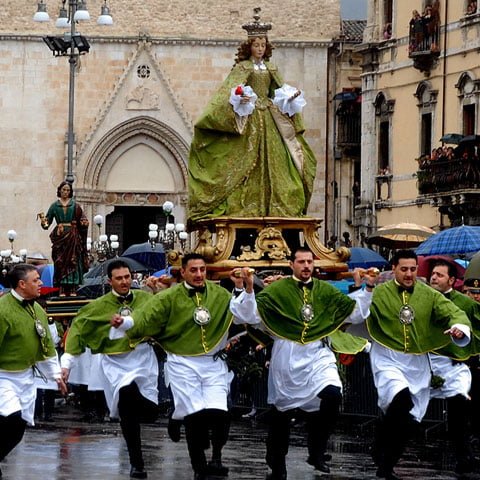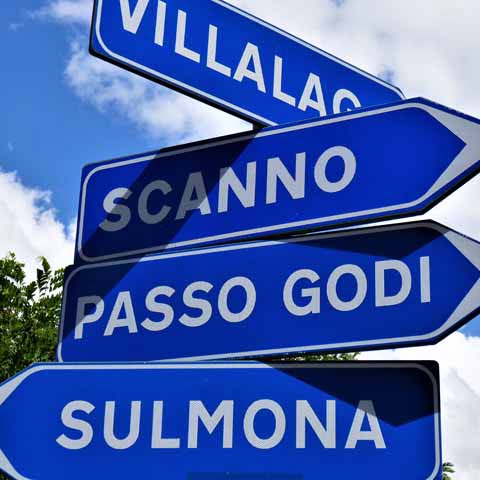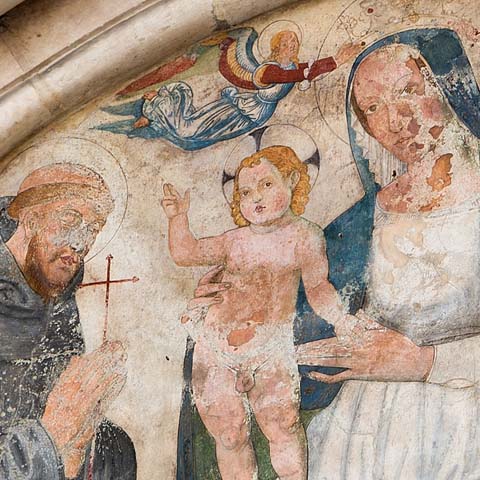In the heart of Italy lies one of the country’s best kept secrets and most enchanting cities, Sulmona. This mountain city is small, quaint, and filled with Italian charm and warm and generous people. Whether you are interested in outdoor or indoor activities, this delightful city holds a bit of excitement and beauty for visitors of virtually every age.
FESTIVALS AND EVENTS
The city of Sulmona is rich in ancient history and tradition, and its annual festivals and events largely reflect that heritage. The two main annual events in the city are Giostra Cavalleresca and Madonna che Scappa.
Madonna che Scappa is a well-attended religious event taking place during Easter. In addition to its religious tones, the event is thought to mark the welcoming of spring after a long winter. A procession begins where the people carry a statue of the Madonna cloaked in a black mourning cape across Piazza Garibaldi toward a statue of the resurrected Christ. It is said that when the Madonna statue sees her resurrected son, the black cloak is torn away to reveal a green dress that symbolizes new life. In that moment, fireworks light the sky, celebratory music fills the air, and doves are said to fly out from beneath the cloak. Legend dictates that if the doves fly high into the air, it will be a good year for the crops.
A largely non-religious local event is the Giostra Cavalleresca. The annual summer festival is in the style of a medieval festival complete with jousting. Over several days, there are at least three jousting tournaments that pit local neighborhoods, villages, and European riders against one another. The tournaments are typically marked with a procession called Corteo Storico in which people are dressed in elaborate period costumes. Many visitors say the steps of the Palazzo dell’Annunziata on Corso Ovidio offer one of the best views of the festival. Following each competition, many of the neighborhoods host their own parties to celebrate their participation and the city comes alive with laughter, music, and great food.
OUTDOOR ACTIVITIES
In a town like Sulmona, where a picturesque setting of snowcapped mountains makes outdoor experiences even more breathtaking, it makes perfect sense that some of the outdoor city squares are a draw for visitors.
The Piazza XX Settembre is one of the quieter city squares of Sulmona and features a simple yet beautiful cobblestone street design. Although the square is bordered by several interesting buildings, the main attraction tends to be a bronze statue of the Roman poet Ovid which sits in the middle of the square. The Piazza XX Settembre is a wonderful place to sip on a hot cup of coffee, enjoy locally made Sulmona confetti (sweet, covered almonds), and ponder the beauty of the Italian way of life.
Sulmona’s largest city square and possibly the busiest, is Piazza Garibaldi. This massive open-air square is bordered by colorful buildings that give way to majestic mountains rising behind them. It is quite common for celebrations and weekly markets featuring produce and other goods to take place here. Many of the square’s visitors are drawn in by its proximity to the Sulmona Aqueduct. In Piazza Garibaldi, visitors can see the Renaissance Fontana del Vecchio, meaning Fountain of the Old One. The fountain is said to be representative of Solimo, the founder of Sulmona. Be sure to spend a little time here one evening to soak up the local scene as you enjoy a delightful coffee and dessert.
Considered to be somewhat of a rare and interesting site is the nearby Eremo di Sant’Onofrio al Morrone. Also known as the Hermitage of Sant’Onofrio al Morrone, this structure which resembles a house is actually built into the side of the Morrone Mountains. Be warned that the climb to the hermitage can be steep, but is considered to be well worth the effort. The hermitage has great historical significance as it is said that in the late thirteenth century this is where Pietro da Morrone was told he would become a pope. Visitors will find that the views down into the valley below are simply stunning.
Sulmona’s historic city walls, which date back to the fourteenth century, are still standing to this day in specific parts of the city. A few of the original gates remain as well, including Porta Filiamabili, Porta Japasseri, and Porta Bonomini.
INDOOR ACTIVITIES
While visiting the Hermitage of Sant’Onofrio al Morrone, do not miss the Santuario di Ercole Curino. The area is actually the remains of a Roman-era structure known as the Shrine of Hercules Curinus. The ruins sit just below the hermitage and are fascinating to see.
The Abbazia di Santo Spirito Al Morrone, also known as the Abbey of the Holy Spirit at Monte Morrone, was established in the thirteenth century. Although the structure was originally built to be an abbey, it became a prison for a time before it became the museum it is today. It is located in Badia at the foot of the Morrone Mountains.
If visiting the Palazzo dell’Annunziata in Corso Ovidio, be sure not to miss the delights of Museo Civico. The museum has several outstanding exhibits on archaeology, religious art, and Abruzzo’s culture. One of the highlights of the various exhibits are the traditional costumes on display, which feature traditional wear of the various villages throughout the years. The museum is also known for presenting a thorough history of shepherding, which was vital to the development of the Abruzzo region.
The Museum of Natural History offers an interesting look at Sulmona’s natural surroundings and past. Visitors to the museum will find an extensive exhibit dedicated to local insects with more than 4,000 specimens on display. The museum also showcases local minerals and fossils discovered in the surrounding area.
FAMILY
One of the main thoroughfares of the city, Corso Ovidio, has something for everybody. This busy street is named after Roman poet Ovid, who was born in the city in 43 BC. It is one of the most important avenues in Sulmona and connects the Sulmona Cathedral of San Panfilo and several major piazza which account for much of the city’s daily traffic.
Visitors that walk the length of Corso Ovidio will find beautiful palaces, quaint cafés, gorgeous churches, and interesting shops. Most locals and travelers alike enjoy walking the street during the late afternoon and evening when the city really comes to life.
KIDS
Although perusing Corso Ovidio is a fabulous way for children to expend some energy and enjoy the heart of the city, there are several other activities that are practically made for youngsters. Happylandia is an often-visited indoor recreation area complete with a climbing structure, ball pit, toys, and a variety of video games. It is worth noting that Happylandia is open primarily in the late afternoon and early evening. Young children may also enjoy a couple of area playgrounds within the city, including Parco Fluviale.
UNIQUE EXPERIENCES
One of the more unique experiences in Sulmona is to visit the Museo dell’Arte Confetteria. The museum is actually located in the Fabbrica Confetti Pelino which was established in the late eighteenth century. Pelino was one of the most famous manufacturers of confetti, which are sugar-coated almonds made in almost every color imaginable that are then constructed into marvelous life-like shapes, such as flowers.
This particular museum is dedicated to preserving the tradition of Sulmona confetti by sharing the sweet treat’s history and story. Here visitors can find fascinating examples of antique confetti making equipment, a reconstructed laboratory, and if they are lucky, maybe a little taste of some authentic confetti.
Known as the city of confetti, Sulmona offers plenty of interesting sites for the travelers that choose to visit. During a trip to Sulmona, visitors are rewarded with historic architecture, breathtaking natural scenery, and fascinating culinary traditions.
Travel Guides
The Abruzzo Region of Italy
The Cities of Abruzzo, Italy







